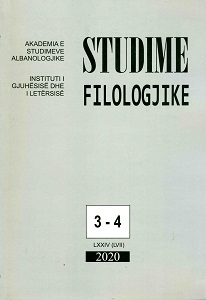Tragjedia e Etëhem Haxhiademit përmes disa kritikëve të kohës (të viteve ’30-’40)
Etëhem Haxhiademi’s tragedy through some critics of the time (the '30s and ’40s)
Author(s): Gëzim PukaSubject(s): Albanian Literature, Interwar Period (1920 - 1939), WW II and following years (1940 - 1949), Theory of Literature, Sociology of Literature
Published by: Qendra e Studimeve Albanologjike
Keywords: Etëhem Haxhiademi; Albanian literature;
Summary/Abstract: This article recalls the literary criticism atmosphere of the '30s and '40s in respect of the literary work of the author Etëhem Haxhiademi, who became known in those years for some tragedies that he published within a relatively short time. Throughout this paper we will compare various critics and look at how a certain critical approach seeks to confront Haxhiademi's latest literary work within the framework of a weak dramatic literature production. One of the most discussed works of Etëhem Haxhiademi is the tragedy “Skanderbeg”. This work is promoted by Vangjo Nirvana (Vangjel Koça), Branko Merxhani, Aleksandër Xhuvani, Elvira Tarro, Jup Kastrati etc. On the other side, there are the polemicists towards this work: Stefan Shundi (whose pen name was Gjergj Kuka) and Behar Shtylla (or Bardhi ShtyIla), less vitriolic than Shundi. The article estimates that the mass circulation of newspapers and magazines engaging with culture and literature during those years managed to offer a wide range of perspectives. Literature was reviewed as part of customs and trends related issues, in a tone that suggests re-creation. These newspaper critics aimed at guiding the reader towards the right aesthetic choice. The paper also deals with principles and shows the ideological basis on which the critical hypotheses are formed, bringing to light the various procedures and results. The actualization of this polemic is beneficial for the today’s literary critic and reader, because it demonstrates the great usefulness of the figure of the critic, who interacts with texts and follows the process of making literature.
Journal: Studime Filologjike
- Issue Year: 2020
- Issue No: 03-04
- Page Range: 53-64
- Page Count: 12
- Language: Albanian

